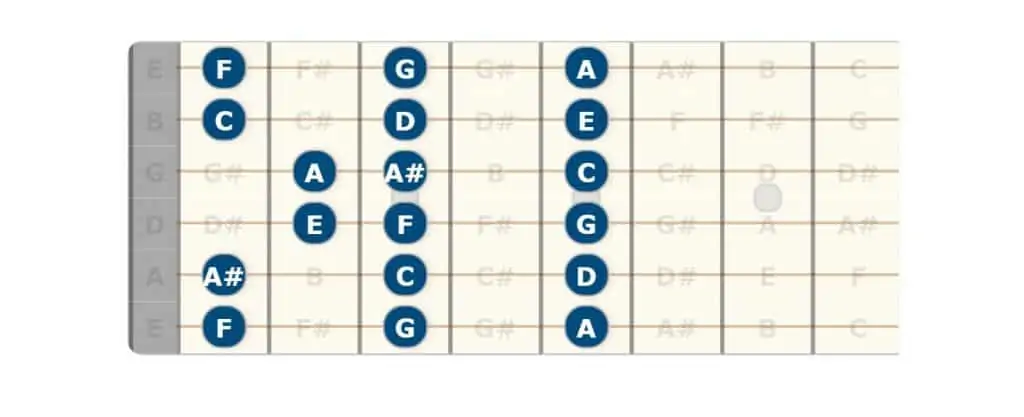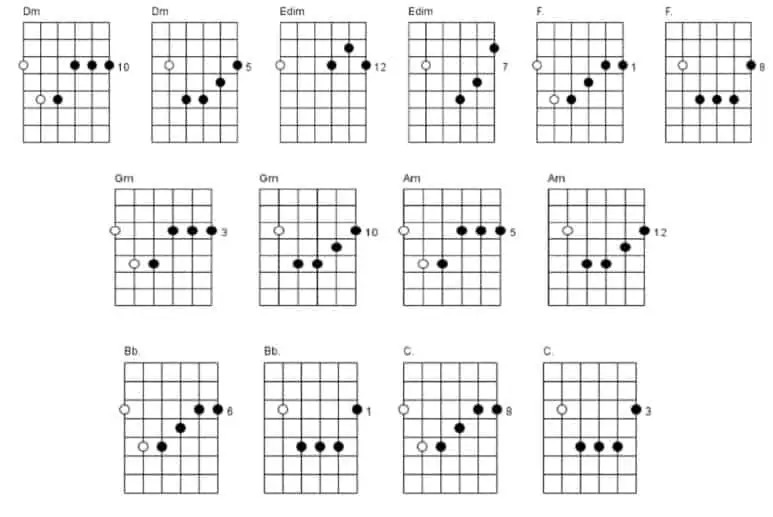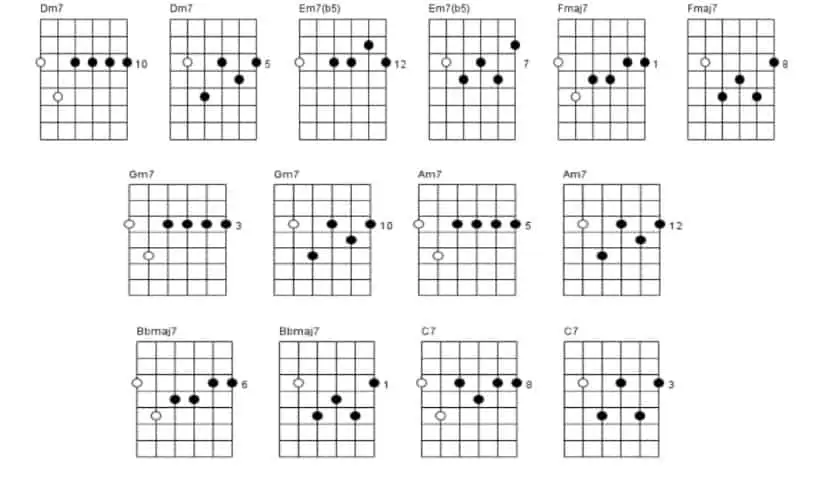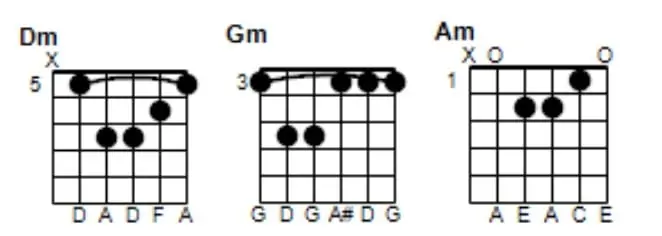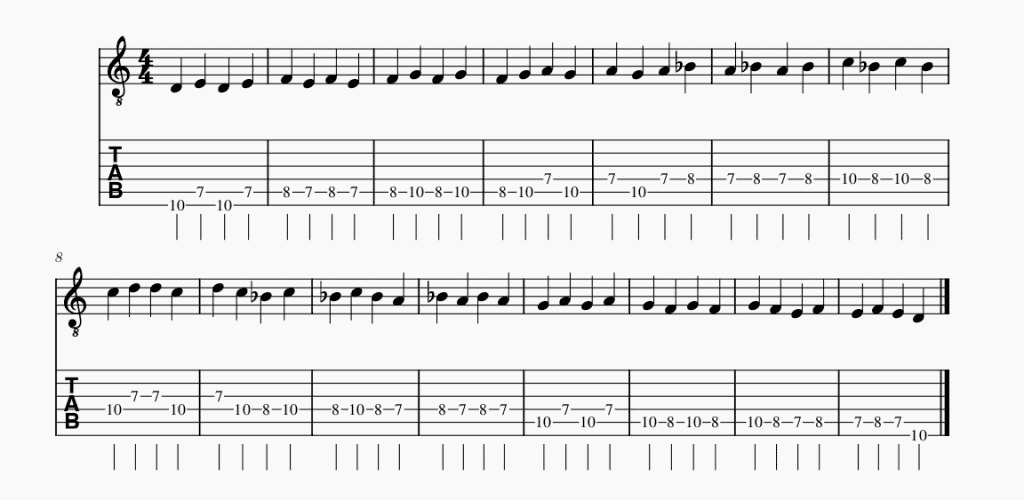Scales are considered one of the most fundamental concepts in music. They are known to have a varied use. Most songs as we know them are based on the key system. Not to mention that scales can be a good way to start understanding music theory. Most guitar teachers emphasize learning them.
Hundreds of scales exist in the music world. Due to this scales can become quite overwhelming for the beginners. If you are just starting to explore this concept then you might have already started learning major, minor or pentatonic scales. In this article we will take a look at how a D minor scale is built and how to play it on guitar fretboard.
But just knowing a scale and playing it up and down can be unproductive and downright boring after some time. So we will also take a look at how you can have fun and challenge yourself while practicing the scales. We will also take a look at the chords that you can use for writing your own music using this scale. I would also like to suggest that you try to create your own exercises based on the exercises given here. Learn more about how to practice guitar scales. So let’s dive in!
Contents
D minor scale theory
Guitar music theory in general, is based on 12 notes. The distance between any two notes is called an interval. All the scales are built using a combination of these intervals. These intervals are what gives a scale its characteristic feel. Generally, a minor scale is said to have a sad, melancholic feel. Minor scales have been explored and used in a vast variety of genres and songs.
There are three types of widespread minor scales. The natural minor, the harmonic minor and the melodic minor. All three scales are slightly different from one another but they can feel completely different to hear. If we compare these three scales to the major scale, then we can see that a natural minor scale is a major scale with the 3rd, 6th and 7th notes flattened by a half step. Similarly, a harmonic minor scale is a major scale with only 3rd and 6th notes flattened whereas a melodic minor scale is a major scale with only the 3rd note flattened by a half step.
Now let’s take a look at how to build a natural, harmonic and melodic minor scale.
The formula of a major scale is R-W-W-H-W-W-W-H where R represents that root note of the scale, W represents a Whole step also known as a tone and H represents a half step also known as a semitone.
- The formula for a natural minor scale is R-W-H-W-W-H-W-W
To build a D natural minor scale, we take this formula and apply it to the D root note. This will give us the following notes:
| D | E | F | G | A | Bb | C | D |
On a single guitar string D, it would look like:
- The formula for a harmonic minor scale is R-W-H-W-W-H-(W+H)-H
To build a D harmonic minor scale, we take this formula and apply it to the D root note. This will give us the following notes:
| D | E | F | G | A | Bb | C# | D |
On a single guitar string D, it would look like:
- The formula for a melodic minor scale is R-W-H-W-W-W-W-H
To build a D melodic minor scale, we take this formula and apply it to the D root note. This will give us the following notes:
| D | E | F | G | A | B | C# | D |
On a single guitar string, it would look like:
How to play D minor Scale on guitar
There are many ways by which you can play a scale on the guitar. Guitar being an instrument with patterns, you will find many patterns for the D minor scale. In this article we will focus on Natural D minor Scale.
Single string Shape:
To get a feel for the intervals, you should first try to play a scale on a single string. Doing this will help you memorize the notes of the scale and also familiarise you with the intervals and placement of root notes on the fretboard.
Taking the one string scale shape given above, try to construct the Natural D minor scale on other strings.
Box Shapes:
Box shapes can be a really good place to practice the scale. You can practice this scale shape to build your speed and it will also help you see the patterns on the fretboard. We will take a look at some exercises to help you internalise the scale in a later section. A major advantage of learning these shapes is that you can transpose it to any fret. That is if you play the same shape starting on a different fret it will give your natural minor scales with other root notes.
- Shape 1
- Shape 2
- Shape 3
- Shape 4
Connecting shapes
Once you are familiar with the scale and can play it up and down in the box shape, you can start to connect the shapes. Being stuck in a box can hinder your growth as a guitar player. So ideally an advanced guitarist should be able to play the scale all over the fretboard. But that is the end goal. What you can do to give yourself a chance to get out of the scale box is to connect various shapes of the scale. This can be very frustrating at the beginning and you will play wrong notes often. But remember that frustration means that you are learning something. Take things slow and you will be able to play like you always imagined.
Some examples of how you can connect different shapes are:
- Shape 1
- Shape 2
Scale degrees
Different notes of the scale are given different names based on their position as well as the function. So in a D minor scale, the scale degrees are:
- D (Tonic): D is the root note of the scale. It is the note that sounds like the “home note”. The complete scale is built on this founding note and we will return to this note frequently.
- E (Supertonic): It is the second note of the scale and forms a major second interval with the root mote D. This scale degree can be missing from some scales like the D minor pentatonic scale.
- F (Mediant): F is called the mediant because it is the middle note of the chord built on the root note that is the D minor chord. F forms a minor third interval with the root note D.
- G (Subdominant): It is one of the most important scale degrees. It is named subdominant because it lies in the perfect fifth interval below the tonic. It forms a perfect fourth interval with the root note D.
- A (Dominant): This note can be considered the most important note in a scale after the root note. This is because classically this scale degree is used for a satisfying resolution of a musical phrase to the tonic. It forms a perfect fifth interval with the root note D.
- Bb (Submediant): It is the sixth scale degree. It forms a minor sixth interval with the root note D.
- C (Subtonic): It is the seventh scale degree and it forms a minor seventh interval with the root. This scale degree is absent in the harmonic and melodic minor scales as the minor seventh interval is replaced by major seventh interval which is in turn named as the leading tone.
Chords in D minor Scale
- Diatonic Chords
All scales have chords that can be formed using only the notes of the chosen scale. In the key of D minor, we can build a total of 7 triad chords, each chord based on a different note of the scale. These are called diatonic chords. To build these chords we will consider the scale in ascending order. After that we will select a root note on which the chord will be built. Now in the final step, we will choose two other notes. Omit a note after the root and select the one after that. Then again omit a note and select the one after that. This will give us our triad for any selected note of the scale.
For example, if you want to build a triad on the note A(dominant or simply 5th note of the scale) then in the scale of D minor (D-E-F-G-A-Bb-C-D), select note A, omit note Bb, select note C, omit the D and finally select E. This gives us the A minor triad.
If you do this for every note of the scale then you will get following results
| Root note | Chord notes | Type of Chord |
| D | D-F-A | Minor Chord |
| E | E-G-Bb | Diminished chord |
| F | F-A-C | Major Chord |
| G | G-Bb-D | Minor Chord |
| A | A-C-E | Minor Chord |
| Bb | Bb-D-F | Major Chord |
| C | C-E-G | Major Chord |
Tip: The sequence of these types of chords is the same for all natural minor scales. That is, a chord built on the first degree of any natural minor scale will be a minor chord. This will be similar for all other scale degrees. It is an important fact that will give you the chords in any given minor scale instantly.
- Seventh Chords
There are different types of seventh chords that vary slightly from one another.
- Major seventh chord- Major chord+major seventh interval
- Minor seventh chord- Minor chord+Minor seventh interval
- Dominant seventh chord- Major chord+minor seventh interval
- Half Diminished seventh chord- Diminished chord+minor seventh interval
In the key of D minor, we can use following seventh chords
| Root note | Chord notes | Type of Chord |
| D | D-F-A-C | Minor Seventh Chord |
| E | E-G-Bb-D | Half Diminished Seventh chord |
| F | F-A-C-E | Major Seventh Chord |
| G | G-Bb-D-F | Minor Seventh Chord |
| A | A-C-E-G | Minor Seventh Chord |
| Bb | Bb-D-F-A | Major Seventh Chord |
| C | C-E-G-Bb | Dominant Seventh Chord |
- Extended and Suspended Chords
Some of my favourite extended and suspended chords that I use most frequently in D minor scale are:
| Root note | Chord notes | Type of Chord |
| D | D-E-A | Dsus2 |
| D | D-G-A | Dsus4 |
| D | D-F-A-E | Dminadd9 |
| F | F-G-C | Fsus2 |
| F | F-A-C-G | Fadd9 |
| G | G-A-D | Gsus2 |
| C | C-E-G-D | Cadd9 |
Some common Chord progressions in D minor Scale
A sequence of chords is called a chord progression. These can be very simple chord progressions like the ones used in most of the pop music to extremely complex chord progression like the ones used in Jazz music. You can use any of the chords given in above charts to create beautiful chord progressions in D minor scale. Let’s take a look at some common chord progressions.
We will use the common symbols used for each chord.
- i-iv-v
This is one of the most used chord progressions in popular music. The chords used will be Dm-Gm-Am
- i-VI-VII-III
Chords used will be Dm-Bb-C-F
Fear of the Dark by Iron maiden uses this chord progression.
- VII-iv-i-v(vmin7)
Chords used will be Bb – Gm – Dm – Am(Am7)
Some exercises to internalise the D minor scale
It is important to practice your scale in more than just ascending and descending note patterns. First reason for this is that playing just up and down in order will never give you a solid grasp of the scale and second is that it simply just gets boring after some time. Therefore, we need to dive in and practice in different patterns.
I will definitely suggest you to first practice the scale in order and get yourself comfortable. Also you should practice with a metronome and keep track of the speed that you are comfortable with.
Here are some exercises that you can practice to not only learn the D minor scale but internalise it and use it effectively. Feel free to create variations of these patterns and apply them to the different shapes of D minor scale.
- Exercise 1
- Exercise 2
- Exercise 3
Conclusion
Try to create your own process for learning scales. Create your own exercises by taking the above exercises as a reference. Also remember that by trying to write your own music in a given scale is the best way to explore that feel of the scale. So keep practicing and most importantly, Have Fun!





